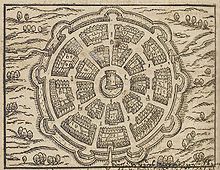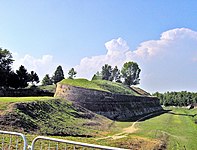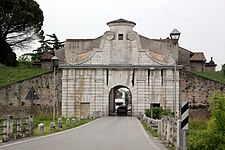Palmanova
| Palmanova | ||
|---|---|---|

|
|
|
| Country | Italy | |
| region | Friuli Venezia Giulia | |
| Coordinates | 45 ° 54 ' N , 13 ° 19' E | |
| height | 27 m slm | |
| surface | 13 km² | |
| Residents | 5,447 (Dec 31, 2019) | |
| Population density | 419 inhabitants / km² | |
| Post Code | 33057 | |
| prefix | 0432 | |
| ISTAT number | 030070 | |
| Popular name | Palmarini | |
| Patron saint | Santa Giustina di Padova | |
| Website | www.comune.palmanova.ud.it | |
Palmanova ( Furlanic : palm ) is a municipality with 5447 inhabitants (as of December 31, 2019) in the Friuli-Venezia Giulia region . It was laid out as a planned town at the end of the 16th century , and its typical star-shaped floor plan has been preserved to this day. It has a community area of about 1300 ha and is located at an altitude of 27 m slm
location
Palmanova is located south of Udine immediately east of the motorway triangle of the A4 ( Venice - Trieste ) and the A23 (junction to Villach ). The Udine – Trieste / Venice railway line passes Palmanova. The distance to Udine is around 20 km and to Venice around 120 km.
The neighboring municipalities are Bagnaria Arsa , Gonars , San Vito al Torre , Santa Maria la Longa , Trivignano Udinese and Visco .
history
The founding date is October 7, 1593, the 22nd anniversary of the victory of Lepanto and the day of St. Justina of Padua , who was designated the patron saint of Palmanova. Palmanova was laid out as a fortress city of the Republic of Venice to protect against the Turks . Above all, the city was to be developed into the most important land base of the Venetians - a plan that failed. Today only the almost round, gigantic main square, which is completely oversized for the small town, bears witness to this intention.
Every year at the end of August, the city commemorates the events of 1615 when it became the headquarters of the Venetian troops deployed against Austria in the Uskok War.
Later, the fortress served as a defense against the Habsburgs , who ruled neighboring Friuli and Gorizia . The city fulfilled this task for over two hundred years before it was conquered by Napoleon , who ceded Veneto to Austria in the Peace of Campo Formio in 1797, incorporated it into his Kingdom of Italy from 1806-1814 , but then had to cede it to the Austrians. The capitulation of Venice was signed in Palmanova.
In 1866 Palmanova finally fell to Italy. During the First World War , Palmanova was an important base for the Italians in the hinterland of the Isonzo front ; accordingly, military hospitals and military training areas were created here. Palmanova was conquered by the Austrians on October 30, 1917 in the course of the twelfth battle of the Isonzo (Battle of Karfreit) and suffered destruction from artillery fire. Today a military museum in the city commemorates this time, among other things. In 1960 the city was declared a national monument and in 2017 it was included in the UNESCO World Heritage Site .
Plant and sights
Palmanova was planned and also implemented as an ideal city type with a radial road network. Special features were relatively wide, regular streets, so that the soldiers from the center (parade ground) could get to the defenses (city wall) as quickly as possible. The commanding officers lived in the center, the soldiers of the line all around and the mercenaries along the fortifications.
The three large city gates Porta Aquileia, Porta Udine and Porta Cividale have been preserved, in some cases even with their early baroque porches. The gates were probably designed by Vincenzo Scamozzi , a renowned architect from Vicenza. The outer three fortress rings were laid out from the inside to the outside and form a regular hexagon or a nine-pointed star. The innermost ring with the flood ditch (fossato) was built between 1593 and 1620, and between 1665 and 1683 another nine (smaller) bastions (so-called " ravelins ") were inserted into the spaces between the nine bastions . Napoleon finally expanded the complex again by building nine lunettes in front of the older bastions .
The city is home to three churches: the small Franziskuskirche (around 1600), which in the 19th century was used as an arsenal in the meantime; the Church of the Nativity of the Virgin Mary (built by Franciscans around 1660), which was rededicated by the French as a warehouse and has since been profaned, and the cathedral (built 1615–1636) with a single-nave column-free interior, three chapels and four side altars.
Palmanova also has a city museum and a military museum, a theater with a front made up of six columns, a number of military buildings (magazines, arsenals) and other buildings: The Palazzo del Provvedittore Generale (1598), built as the seat of the local representative of the Republic of Venice, the Loggia of the Great Guard, Santo Monte de Pietá with a Pieta statue from the end of the 17th century - the building served the poor relief in the city, the Palazzo Del Governatore dell'Armi as the seat of the military commander of the fortress and finally the Palazzo del Ragionato, the seat of the treasurer of Palmanova. The municipality's town hall is located in Piazza Grande.
Culture
Palmanova is home to the Mitteleuropa Orchestra , a 47-piece symphony orchestra .
More planned cities
Today there are only a few ideal baroque cities where the original geometric structure is as clearly recognizable as in Palmanova. Comparable cases can be found above all in the fortress towns established by Vauban (especially Neuf-Brisach and in the old town of Saarlouis ), in Karlsruhe and the Transylvanian fortress town of Alba Iulia in Romania (German name: Karlsburg (formerly Weißenburg), Transylvania).
See also: planned city , ideal city
photos
sons and daughters of the town
- Giuseppe Bernardino Bison (1762–1844), painter
- Ardito Desio (1897-2001), explorer
- Ilenia Vitale (* 1995), sprinter
literature
- Roberta Costantini, Fulvio Dell'Agnese, Micol Duca, Antonella Favaro, Monica Nicoli, Alessio Pasian: Friuli-Venezia Giulia. I luoghi dell'arte , pp. 224-225; Bruno Fachin Editore, Trieste
Web links
- Aerial view with the hexagonal central main square
- Plan of the city 1598 in Civitates orbis terrarum by Georg Braun and Frans Hogenberg
Individual evidence
- ↑ Statistiche demografiche ISTAT. Monthly population statistics of the Istituto Nazionale di Statistica , as of December 31 of 2019.
- ↑ ANSA announcement of July 9, 2017 (in Italian), accessed on July 11, 2017
- ↑ Central Europe Orchestra











